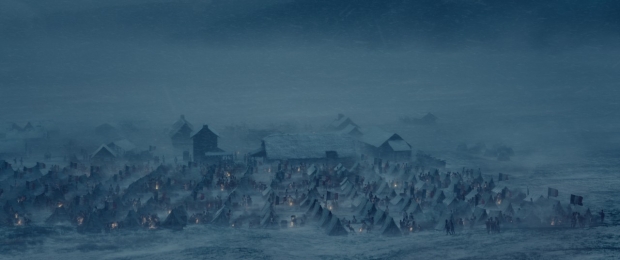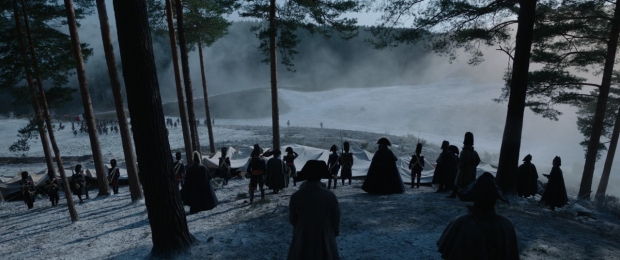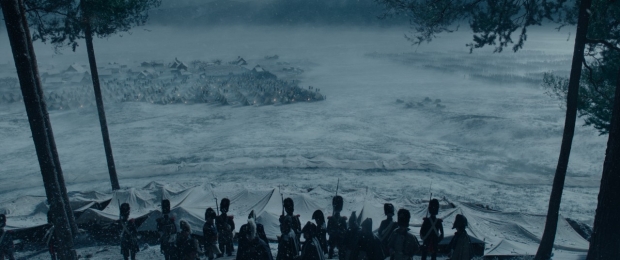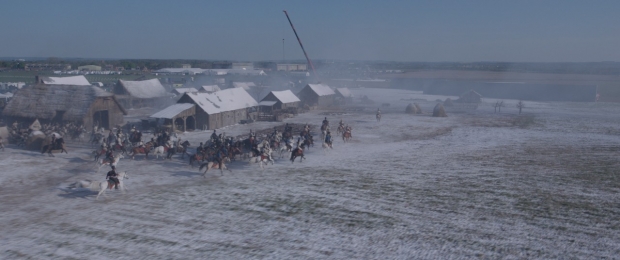VFX supervisor Simone Coco’s team took on the French general’s famous Battle of Austerlitz, stitching together three different locations, as well as creating thousands of unique, accurately outfitted CG soldiers and horses.
While epic battles are not in short supply in Ridley Scott’s Napoleon. But a centerpiece of the action is the Battle of Austerlitz, where the French General Napoleon Bonaparte demonstrated his military tactic prowess in defeating the Russian and Austrian armies by taking advantage of the frozen lake environment and his tactical use of cannon fire. Responsible for stitching three different locations together into one for Scott’s biopic was ILM, under the direction of production visual effects supervisor Charley Henley.
Extensive previs was produced to figure out how to get the forest, village constructed on an airfield, and studio water tank working seamlessly together. “We shot at Abingdon Airfield, where they constructed this amazing real set,” recalls Simone Coco, visual effects supervisor, ILM. “When I went on set, it was unbelievable. Every single prop, the village, hundreds of costumes, and horses. It was nice to be on the battlefield in the 18th century. That was the main part where the battle happened. They shot the hillside where Napoleon is standing and watching the battle with the hidden cannons in Bourne Wood. And then there was the water tank at Pinewood Studio, which is at the end of the sequence when the Russian soldiers get killed by the cannons while running away from the French infantry.”
The first step in achieving integration was to scan each location. “When scanning, wherever we were, they made sure it fit into the master plan,” Coco says. “The different types of weather weren’t a big problem because Bourne Wood was mostly inside of the trees and overcast. We graded and changed some of the background to marry them together quite nicely.”
Principal photography took place in the summer in what was supposed be a frigid wintry setting. “They shot with 14 cameras for this battle scene,” notes Coco. “It was crazy. Usually, Ridley Scott does one or two takes, and he’s done. A big part of Austerlitz is the fog because, it hid the French infantry. The Russian and Austrian armies didn’t expect this army to come all at once. Once you have the fog in the foreground, it covered up some of the lighting. If you go to Italy when it’s snowing, there is a lot of wind, and sometimes you get sun spill, so we played with that idea. In other areas, it was overcast.”
The musket fire itself would create a dense cloud of smoke that had to be art directed to ensure readability. According to Coco, “You cannot always show exactly how the thing will look in real life. You have to put a lot of art direction into it, otherwise you’d won’t be able to see anything, especially if 100 cannons fire at the same time and there’s fighting on the ground with snow and ice.” Neil Corbould and his special effects team provided a solid practical base with the snow and cannon fire. “When you have Ridley shooting everything for real as much as possible, it makes things easier for us to match exactly what they’re doing,” Coco shares. “What we did was extend their work and make it much bigger. We kept everything that they shot.”
Maintaining a sense of direction and geography was important to avoid confusing the audience with the unfolding action. “It was challenging for us to make people understand where things were, so we extended a bit of the village set,” remarks Coco. “Then we created this map for us to understand where things were. The village was in the middle, Napoleon’s point of view was from the hill, and on the far end of the lake we have what was called ‘Napoleon’s Island’. On the right side, you would see the Russian arming coming. Those four points are where people would understand where things were. The environment team did an amazing job based on a lake in Italy. We went to Italy as well, scanning a lot of frozen lakes to make sure that we matched to real locations. At one of the locations, funny enough, we had to go on a three and a half hour hiking trip on top of Lake Garda in Northern Italy because the helicopter could not get in there. We took reference pictures to use on top of the final images with mountains in the background and to make sure that everything was as real as possible.”
Creating CG soldiers that integrated with the onset extras was the biggest challenge for ILM. “We needed to put our CG solider next to the plate photography solider,” explains Coco. “When you put so many crowds in the background, you have to make sure that none of them look the same. Every single one had to have something a little different. They move differently, and the seams of clothes are slightly altered. They scanned a lot of soldiers. We had about 65 different selects, and from those, we created our crowd system for the French, Russian, and Austrian armies. We also created different horses based on the real ones that were onset. In the end, we had 63,539 variations of crowd agents. There is not one who looks the same as the other.”
Motion clips were produced via motion-capture for each crowd agent. “Charley Henley shot a lot of clips throughout the course of five days of groups of soldiers fighting and people dying and dragging wounded soldiers around,” says Coco. “We had a huge number of clips that had to be applied to each agent so none of them would do the same thing.” The horses were tricky. “Working with animals is always a challenge,” he continues. “We had about 300 different clips, and they had a massive space where the horses could run and be motion captured. When you put the digital version next to the real horse in plate you could not see the difference. It was great.”
Cannonballs obliterate the surface of the frozen lake, turning it into an icy, watery grave. “Some real in-camera explosions were shot, but they also used polystyrene ice sheets for the actors to interact with,” reveals Coco. “Putting all the pieces together was challenging because the layout artists had to track every single piece that they shot and replace it with a proper ice sheet. Then the effects artists would replace those and create water and snow explosions combined with a crowd. They did some mocap as well for people being thrown by the explosions.”
Everything was rendered in 4K because of AppleTV+ streaming specifications. “Luckily for the underwater shots, they captured most of the foreground for real with the cannonball going through it,” Coco says. “Then we added a second layer of water effects.” Interestingly, the most complex shots involved horses running down the hill. “We had to match the horses in the plate photography and had to add about 2,000 different horses,” Coco adds. “One of the biggest challenges was making sure that we had enough motion clips, so the horses didn’t look the same and that the simulation for each agent was different.” He goes on to note that the mocap motion clips proved to be the most challenging “because we needed to get many different variations, so when you put that many crowds into the shots, they don’t look and move the same. All those clips needed to be cleaned up by the animators, and it took quite a long time. It was a huge amount of work. The timeframe was so short; we had six months, and we needed to make sure we worked cleverly and didn’t make any mistakes along the way.”




















